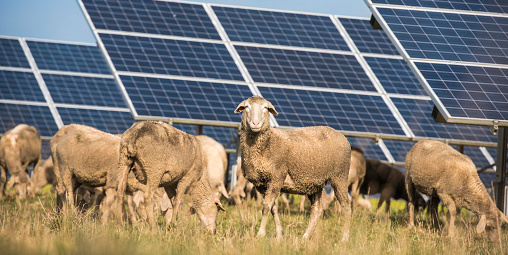Introduction
The food and agriculture sector accounts for about 30% of global energy consumption. A significant portion of this energy demand is generated by the production, processing, and transport of livestock feed, largely due to the energy-intensive nature of manufacturing synthetic fertilizers applied to feed crops. Emissions from on-farm energy use, the construction of farm buildings and equipment, and post-farm gate processing and transport of livestock products account for the remaining fossil fuel emissions. This sixth principle provides guidance for contributing to clean energy development in livestock production. It applies to the entire livestock value chain for all livestock species.
Efficient and renewable energy generation provides a range of environmental and economic co-benefits.
Improving energy efficiency can reduce both emissions from fossil fuels and energy costs for farmers and processors. Key approaches include improving the maintenance and operating time of existing machinery, as well as introducing new machinery purposed for energy savings, such as energy-efficient milk chillers.
Generating renewable energy along the supply chain and off-farm can reduce energy expenditure while also contributing to climate change mitigation. On-farm bio-digesters can be used to capture renewable biogas energy from livestock manure and other farm by-products. Digesters at various scales can power households, farms, and processing operations (Principle 5). Solar installations on rooftops can also contribute to powering buildings and machinery on farms and in processing plants.
Solar and wind energy installations may also be constructed on marginal lands unsuitable for crop production or pasture, and with the use of net metering devices, be used to sell energy back to the grid and/or to offset on-farm emissions. In rural areas not connected to the grid, these installations can provide opportunities to improve rural energy access and resilient energy diversification.
Points of Consideration:
Do project beneficiaries use fossil fuel? If so, in project design, incorporate incentives for efficient and renewable energy generation:
✓ Increase energy efficiency:
- Optimize management of machinery and equipment.
- Adopt devices purposed for energy savings.
✓ Increase renewable energy generation along the supply chain:
- Incorporate biodigesters to power household, farm, and processing
operations.
- Incorporate solar installations on rooftops and pastures.
- Incorporate wind energy installations on marginal land to power
processing and other larger operations.
✓ Adopt a net metering device to sell renewable energy back into the grid and/or provide livestock sector carbon offsets.
✓ Include a baseline and indicators in project M&E to track and capture the benefits of contributing to the clean energy economy through the project.
Approaches and Tools:
To increase energy efficiency, optimize management of existing machinery and equipment. Investing in adequate maintenance of existing farm machinery and equipment can avoid energy use associated with malfunctions. Strategic use of fossil fuel-powered machinery can also increase efficiency. For example, running diesel generators at optimal (cooler, evening) ambient temperatures and supplementing tractor use with conservation tillage methods can reduce fossil fuel consumption.
Adopt devices purposed for energy savings. Household energy savings devices can also be used in farm operations to reduce overall energy consumption. These include efficient fluorescent lights to replace incandescent light bulbs; combined heat and power units; energy-efficient motor pumps; and improved insulation to reduce loss of heating energy to weatherizing and air leaks.
To increase the generation of renewable energy, incorporate bio-digesters to power household, farm, and processing operations. Anaerobic digesters or “bio-digesters” are covered pits or tanks in which bacteria convert organic waste, such as manure, into methane biogas through anaerobic digestion. Small-scale digesters can be used to power off-the-grid households; large-scale digesters can power on-farm operations and, in some cases, feed into the grid (WB, 2018; SNV Biogas).
Incorporate solar installations on rooftops and pastures. Producers may install photovoltaic (PV) cells on household and farm building rooftops and/or fields. On rooftops, these solar panels can connect directly to the circuit breaker so that during daytime, when electricity consumption is highest, they are providing electricity directly to the source of consumption. Producers may also install solar-powered outdoor lights, store energy in the daytime to use at night, and therefore have no operating costs.
Incorporate wind energy on marginal lands. Producers may install windmills to generate electricity on lands not suitable for production. These can include small windmills to provide electricity for the household and farm operations, as well as larger windmills off-farm that feed into the grid (see below).
Use of net metering devices to sell back to the grid. For any of the above renewable energies, producers may install net metering devices in coordination with the local energy utility. Any excess electricity can then be sold back to the utility to offset future energy needs or as part of a livestock sector carbon offset program.
Variables to Consider:
✓ Fossil fuel emissions and/or use avoided through the project’s interventions.
✓ Watts/capacity of renewable energy produced due to the project.
✓ Number of biogas installations, solar panels, etc. constructed with project support.
Trade-offs
High up-front production costs. In intervention areas already connected to the grid and/or with low-cost fossil fuel-based energy available, renewable energy installation may present relatively high up-front costs. Analysis of the longer-term costs and benefits of renewable energy production may demonstrate over time cost-savings that offset initial capital investment. Projects may include resources to cover the initial capital where up-front costs are unaffordable for producers. Fossil fuel-based energy providers may also be active stakeholders in agriculture and other sectors; effective promotion and certification programs for renewable energies may require economic and policy planning to reduce market barriers and provide access to subsidies and other public support.

